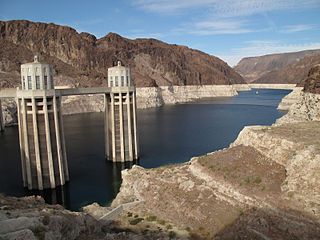More on Floating Solar PV Power Plants

Below are the calcs that the reader provides on the subject. My only comments are:
• Indeed, there are horrific consequences if the volume of water in Lake Mead falls to the point that Hoover Dam needs to be shuttered. However,
• Huge PV installations are not equivalent in value to hydroelectric facilities that offer dispatchable power, and
• Huge PV installations that are far from population centers pose additional challenges.
He writes: Thanks, Craig. Looking at Gary’s article, I realized I had seen it when it came out. Probably that’s what triggered my thinking this time.
Giving a little more thought to the Lake Mead project, I realized that the entire surface would have to be covered to counter all evaporation, so the bottom line is, it can’t be done. But I looked into it anyhow, and my musings are below, for what they are worth.
net annual deficit of about 1.2 million acre feet (1.5 km3).[7] (wikipedia)
What is the estimated annual evaporation of the reservoir? About 800,000 acre-feet each year.
1 acre-foot (acre-ft) = 1,233 cubic meter (m3)
Therefore, loss from evaporation plus the amount outflow exceeds inflow is 800,000 * 1233 = 986.4 million m3.
13.4 megawatt floating solar power plant on the Yamakura Dam reservoir….National Geographic reports that the floating plant will cover 45 acres [and] hold 50,000 photovoltaic solar panels–50,000 Kyocera modules installed over a water surface area of 180,000m2. The plant will generate an estimated 15,635 megawatt hours (MWh) per year — enough electricity to power approximately 4,700 typical households — while offsetting about 7,800 tons**3 of CO2 emissions annually.
1 acre = 4046.86 m2
Therefore, one megawatt would cover 13432.8 m2, or 3.3 acres, and one acre would generate .3 MW.
Kyocera says 50,000 panels would be used for 45 acres, so one acre would require 1111 panels.
At elevation 1,221.4 feet the reservoir covers about 158,500 acres or 248 square miles.
1 mi2 = 640 acres
It would seem that every square meter would have to be covered to reduce evaporation to zero. There would be evaporation reductions from temperature and convection reductions, but setting those incalculables aside,
Lake Mead, with an approximate area of 158,500 acres, is losing 800,000 acre-feet per year from evaporation. Thus, every acre is losing just over 5 acre-feet per year (lake level dropping 5 feet per year!!).
So every acre that was covered with solar panels would generate .3 megawatts and reduce evaporation losses by 5 acre-feet per year.
I’m totally guessing that one third of the surface area is in large enough areas to be easily covered and perhaps if carefully chosen could be compatible with the massive recreational use of the lake.
If so, covering about one-third the surface (50,000 acres) would cut evaporation by 250,000 acre-feet and net annual deficit from 1.2 million acre-feet to .95 million acre-feet, about a 20% reduction. AND it would provide 15 GW of electricity generating capacity–so this project would be similar in size to Gary Tulie’s Salton Sea project (10 – 20 GW).
Gary simply said that the cost would be “very substantial.” I don’t have any knowledge in this area, but I can estimate: Kyocera says 1111 panels per acre, so our theoretical 50,000 acre project would require 55,550,000 panels (whew!!). I found an estimate for a land-based installation of $.6M per 1000 panels. Water installation would be different (and I’d guess cheaper) but I have no idea how much different. Using $.6M/1000 panels and 1111 panels/acre, the installed cost would be $33.33B.
Natural gas generation costs somewhere in the neighborhood of $1500 per kW, or $1.5M per MW, so to build a gas plant with 15 GW of generation might cost $2.3B. So the capital cost of the solar panels is massively greater, but there would be no fuel costs and the added benefit of the reduction in evaporation.
Also, Kyocera estimates that their 13.4 MW floater will offset “about 7800 tons of CO2 emissions annually” (582 tons/MW), so our project might offset 8.7 million tons of CO2 annually, which has to be worth something.
Also, Hoover Dam has 2.1 GW of installed capacity, but recent drought has reduced its output by nearly 1/4 (http://www.circleofblue.org/waternews/2010/world/low-water-may-still-hoover-dam%E2%80%99s-power/). That missing capacity could be more than replaced by the project (in fact, the total capacity would be over 7 times Hoover’s output).
If the same thing were done on the upstream Lake Powell, it’s possible that more water could be released from it to augment the inflow to Lake Meade (in addition to the power generated).

Looking at the figures for Lake Mead and the Hoover Dam, it would appear that the dam typically delivers an average of 2100 full load hours per annum.
By comparison, a single axis tracking solar array at similar latitude in a desert climate in North Africa would deliver around 2000 full load hours. A floating solar array which rotates to track should deliver a slightly higher capacity factor due to the cooling effect of the water.
This being the case the annual electricity output per kW would be around the same for hydro as for solar power.
An advantage of Lake Mead as a site for floating solar is that the first 2 GW or so could share transmission capacity with the hydro capacity – resulting in a substantial saving in the cost of transmission. (hydro generation can be deferred whilst the sun is shining). This should offset some of the additional hardware and installation costs of installing on water.
2 GW of floating solar could make a useful contribution to reducing Lake Mead’s evaporation whilst roughly doubling its annual electricity generating capacity.
Each kWh of hydro generation will require the release of around 2.7 metric tons of water based on 85% efficiency and average water level. If that kWh is instead generated by solar power, that water can remain in the dam unless required for use.